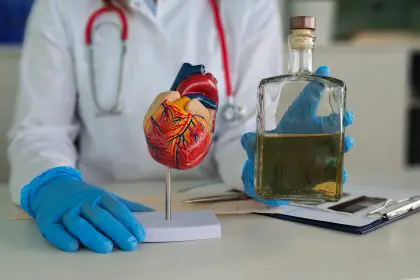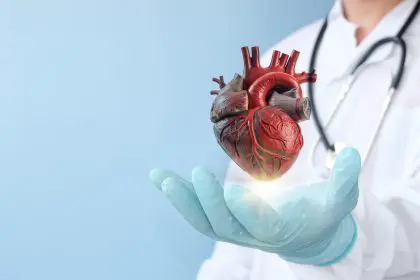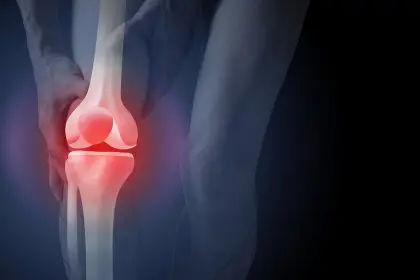Waking up tired even after a full night’s sleep isn’t just annoying – it might be your body’s way of flagging something more serious. While hectic schedules often get blamed for fatigue, persistent exhaustion deserves a closer look, as it could signal underlying health conditions that need medical attention.
Medical experts at leading health institutions emphasize that fatigue becomes concerning when it persists despite lifestyle adjustments. When exhaustion continues despite adequate sleep, good nutrition, and reasonable stress management, further investigation becomes necessary.
Here are seven often-overlooked health issues that might explain why you’re always feeling drained – and what you can do about them.
Iron deficiency anemia saps your energy reserves
Anemia occurs when your body lacks sufficient healthy red blood cells to transport oxygen effectively throughout your body. As the most common blood condition in the U.S., affecting over 3 million Americans, anemia often develops gradually, making its symptoms easy to dismiss.
Many individuals adjust to feeling slightly more tired each day without realizing something’s wrong. By the time medical help is sought, they’ve often been anemic for months.
Beyond persistent fatigue, anemia may cause dizziness, pale skin, cold hands and feet, headaches, and unusual cravings for non-food items like ice or dirt (a condition called pica). Women of reproductive age face higher risk due to menstrual blood loss.
The good news? Most forms of anemia respond well to treatment. Iron supplements, vitamin B12 injections, or dietary changes typically resolve symptoms within weeks. Foods rich in iron include lean red meat, spinach, beans, and fortified cereals.
Thyroid disorders throw your energy regulation off balance
Your thyroid gland functions as your body’s metabolic control center, producing hormones that regulate everything from heart rate to how efficiently you burn calories. When this small butterfly-shaped gland in your neck produces too little hormone (hypothyroidism), every bodily system slows down.
The American Thyroid Association estimates that 20 million Americans have some form of thyroid disease, with women five to eight times more likely to develop problems than men. Despite its prevalence, up to 60% of people with thyroid disease remain undiagnosed.
Hypothyroidism’s symptoms extend beyond fatigue to include unexplained weight gain, sensitivity to cold, constipation, dry skin, hair loss, and depression. Because these symptoms develop gradually, many people attribute them to aging or stress.
Treatment typically involves taking synthetic thyroid hormone (levothyroxine) daily, which usually eliminates symptoms completely when properly dosed. Regular blood tests help physicians monitor and adjust medication levels as needed.
Sleep apnea robs you of restorative rest
You might be spending eight hours in bed, but if you have sleep apnea, your body isn’t getting the restorative sleep it needs. This common condition causes breathing to repeatedly stop and start during sleep, sometimes hundreds of times per night, preventing deep, restful sleep phases.
Sleep medicine specialists note that sleep apnea remains vastly underdiagnosed. Many patients have no awareness that their breathing is interrupted while sleeping unless a partner notices the pattern of loud snoring followed by silence, then gasping.
The condition affects approximately 22 million Americans, with 80% of moderate to severe cases remaining undiagnosed. Beyond persistent daytime sleepiness, sleep apnea can cause morning headaches, irritability, difficulty concentrating, and even depression.
Left untreated, sleep apnea increases risk for serious health problems including high blood pressure, heart disease, stroke, and diabetes. Fortunately, effective treatments exist, from continuous positive airway pressure (CPAP) therapy to dental appliances and lifestyle modifications like weight loss.
Uncontrolled diabetes drains cellular energy
When your body can’t properly process glucose, your cells essentially starve for energy, leaving you perpetually tired. This happens with both diagnosed and undiagnosed diabetes, affecting over 37 million Americans according to the Centers for Disease Control and Prevention (CDC).
Endocrinologists describe the fatigue from uncontrolled diabetes as relentless. Your cells can’t access the glucose they need for energy, even though there’s plenty circulating in your bloodstream.
Undiagnosed diabetes often manifests through a constellation of symptoms including excessive thirst, frequent urination, unexpected weight loss, and blurry vision alongside unusual fatigue. Even people with managed diabetes may experience energy fluctuations when blood sugar levels aren’t optimally controlled.
Regular screening is crucial, especially for those with risk factors like family history, excess weight, or sedentary lifestyle. With proper treatment through medication, diet, exercise, and monitoring, most people with diabetes can maintain healthy energy levels.
Chronic fatigue syndrome causes profound exhaustion
Unlike ordinary tiredness that improves with rest, chronic fatigue syndrome (CFS), also called myalgic encephalomyelitis, causes severe, debilitating exhaustion that persists for months or years. This complex condition affects between 836,000 and 2.5 million Americans according to CDC estimates, yet remains poorly understood.
CFS manifests through overwhelming fatigue that doesn’t improve with sleep, along with symptoms like unrefreshing sleep, cognitive difficulties (“brain fog”), muscle pain, and post-exertional malaise – a severe worsening of symptoms after even minor physical or mental exertion.
Healthcare providers describe the exhaustion from CFS as bone-crushing fatigue that interferes with every aspect of daily life. Many previously active individuals find themselves unable to work or maintain social relationships.
While no definitive cure exists, symptoms can be managed through a comprehensive approach combining pacing activities, physical therapy, cognitive behavioral therapy, and sometimes medication for specific symptoms.
Depression and anxiety deplete mental and physical resources
The connection between mental health and physical energy is profound yet frequently overlooked. Depression doesn’t just affect mood – it can manifest physically through persistent fatigue, sleep disturbances, appetite changes, and decreased motivation.
Mental health professionals observe that many people don’t realize depression can present primarily as physical symptoms. Some patients never report feeling sad but instead experience exhaustion, bodily pain, or sleep issues.
Anxiety similarly taxes physical resources by keeping your body in a prolonged state of high alert. This constant activation of your body’s stress response depletes energy reserves and can lead to burnout over time.
The National Institute of Mental Health estimates that 21 million U.S. adults experienced at least one major depressive episode in 2020, while 31% of adults experience an anxiety disorder at some point in their lives.
Treatment approaches vary based on symptom severity but may include therapy, medication, lifestyle modifications, and stress-reduction techniques. Many people report significant improvement in energy levels once their mental health condition is effectively addressed.
Heart disease causes subtle but persistent fatigue
Heart disease remains America’s leading killer, yet its early warning signs – including unexplained fatigue – often go unrecognized, especially in women. When your heart can’t pump efficiently, every organ and muscle receives less oxygen, resulting in unusual tiredness during routine activities.
Cardiologists report that fatigue is frequently the first symptom of heart disease in women. Unfortunately, many women and their healthcare providers attribute this fatigue to aging, stress, or being too busy, delaying crucial diagnosis and treatment.
This type of fatigue typically appears during physical activity and improves with rest. It may accompany subtle symptoms like shortness of breath, mild chest discomfort, or swelling in the ankles or feet. Women may also experience unusual tiredness in the weeks or months leading up to a heart attack.
Regular cardiovascular checkups are essential, particularly for those with risk factors like family history, smoking, high blood pressure, diabetes, or high cholesterol. Early intervention through medication, lifestyle changes, or medical procedures can prevent serious complications.
When to seek professional help for fatigue
While occasional tiredness is normal, persistent fatigue warrants medical attention. Medical experts recommend consulting a healthcare provider if your exhaustion:
- Persists for more than two weeks despite adequate sleep
- Interferes with daily activities or work performance
- Begins suddenly without obvious cause
- Accompanies other symptoms like unexplained weight changes, fever, or pain
- Worsens progressively over time
Health professionals advise documenting symptoms before medical appointments. Noting when fatigue is worst, what improves or worsens it, and any additional symptoms experienced helps identify potential causes more efficiently.
While awaiting medical evaluation, focus on establishing consistent sleep habits, maintaining balanced nutrition, staying hydrated, managing stress levels, and engaging in gentle physical activity as tolerated.
Medical research confirms that fatigue isn’t just an inconvenience – it’s the body’s way of communicating that something needs attention. Taking it seriously and seeking appropriate care is the first step toward reclaiming energy and improving quality of life.
With proper diagnosis and treatment, most people experiencing persistent fatigue can find significant relief and return to their normal activity levels. The key lies in recognizing when tiredness crosses the line from normal to noteworthy – and taking action when it does.















